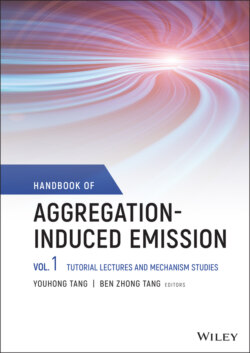Читать книгу Handbook of Aggregation-Induced Emission, Volume 1 - Группа авторов - Страница 20
1.3 Restricted Access to Conical Intersection
ОглавлениеPrevious experimental studies of molecular motions and theoretical analysis of EVC have elucidated the decay pathways of AIEgens, considering the starting and final equilibrium points on the first excited state and the ground state, respectively. Recently, theoreticians have investigated the dynamic features for both the excited state and the ground state of typical AIEgens by scanning the PES along specific molecular motion coordinates or by employing excited‐state molecular dynamics method, which has presented a clear mechanism picture of the photoinduced dynamic evolution for AIEgens [18].
When we look into the NAC between the two equilibrium points on the excited state and the ground state, based on the displacement harmonic approximation, it is the intensive low‐frequency modes that contribute to the energy conversion from the electronic form to the vibrational form. However, the massive molecular motions of a series of AIEgens can lead the excited‐state structures to evolve beyond the assumption of harmonic approximation to form highly twisted structures. In such cases, the conical intersections (CIs) between the excited state and the ground state will become the main cause for the fast nonradiative decay or channels for photochemical reactions [18a].
Taking the dimethyl tetraphenylsilole (DMTPS) as the model compound [18b], the central silole ring can undergo the alternation of the C=C double bond after absorption of photons, which further promotes its motion ability in the excited state. The potential energy profiles of the DMTPS in the excited state optimized by CASPT2//CASSCF method (Figure 1.7b) show that the vibrational relaxation leads to a minimum point in the S1 state with 3.1 eV, at which the central silole ring still keeps planar, whereas along with the twisting of the silole ring, the potential energy profile experiences an energy barrier at 3.54 eV and, finally, leads to a CI point at 3.0 eV between the S1 and the S0 state, at which the silole ring turns into a highly twisted conformation, similar to the structural reorganization of the cis‐butadiene. Since the energy barrier separating the CI and the Frank–Condon region is lower than the vertical excitation energy, the CI is energetically accessible. Once the excited DMTPS species reach the CI, the NAC becomes infinitely large and finally results in the ultrafast nonradiative decay from the S1 state to the S0 state to quench the emission in the solution. But in the crystal, the QM/MM calculation of the potential energy profile shows that the CI is located at 4.91 eV, which is much higher than the vertical excitation energy of 3.65 eV, making the CI energetically inaccessible. Hence, the nonradiative decay through CI can be effectively blocked to recover the strong light emission.
When taking the dynamic evolution along the PES into consideration, it can be found that the TPE derivatives also have abundant decay pathways in the excited state, including both photophysical processes and photochemical reactions [8]. The excited‐state molecular dynamics simulation for 1.5 ps based on the trajectory surface hopping (TSH) model shows that 75% of the simulated trajectories decay to the ground state through a CI and form the cyclization product with a new C–C single bond between the two adjacent phenyl rings. The distance between the two carbons is only 2.0 Å at the cyclization CI. There is 5% of the trajectory decay through the twisting of the C=C double bond. Similar decay features have been found in two TPE derivatives substituted with methyl groups at meta and ortho positions. The scanning of the linear interpolation in internal coordinates (LIIC) path using the OM2/multireference configuration interaction (MRCI) method is presented in Figures 1.6d and 1.7c.
Figure 1.7 (a) Chemical structures and fluorescence quantum yield in the dilute solution of DMTPS, TPE‐4mM, and TPE‐4oM. (b) Schematic illustration of the potential energy profiles of DMTPS in the cyclohexane and the crystal. The potential energy profile in the cyclohexane is optimized at the CASSCF/6‐31G (d) level with the PCM model. The vertical excitation energy for each point is recalculated using CASPT2 with the ANO‐S basis set contracted to Si[4s3p1d]/C[3s2p1d]/H[2s1p]. The calculation in the crystal is performed by using ONIOM(CASSCF/6‐31G(d):UFF) model with recalculating the QM energy by CASPT2.
Source: Adapted from Ref. [18b] with permission from The Royal Society of Chemistry.
Linear interpolation in internal coordinates paths calculated by using the OM2/MRCI method of (c) TPE‐4mM and (d) TPE‐4oM.
Source: Adapted from Ref. [8a] with permission from American Chemical Society.
Upon photoexcitation, TPE‐4 mM can decay through the CI of cyclization with a negligible barrier, which is consistent with the TSH simulation that 88% of the total 558 trajectories drops into the ground state along the cyclization direction. On the other hand, there is only a relatively small barrier of 1.8 kcal/mol between the FC region and the CI for E/Z isomerization, which indicates TPE‐4mM will undergo ultrafast nonradiative decay so that it is almost nonemissive in the solution. On the contrary, for the TPE‐4oM with the methyl groups substituted at the ortho position of the phenyl rings, there are two notable barriers on both the cyclization and isomerization pathways, connecting the FC region with the cyclization CI and the isomerization CI, respectively. Hence, there is no decay for TPE‐4oM to the ground state of the total 568 trajectories in the TSH simulation for 1 ps, which accounts for its higher emission efficiency in the solution.
With scanning the PES or simulating by the TSH method, we can find that vigorous molecular motions of the highly flexible AIEgens in the excited state can lead to the CIs between the excited state and the ground state. These CIs will result in enormous nonradiative decay rates or generate another photoinduced product. Furthermore, the crossing between the excited states can also strongly affect the photophysical behaviors of luminogens that will generate the transition forbidden dark states.
